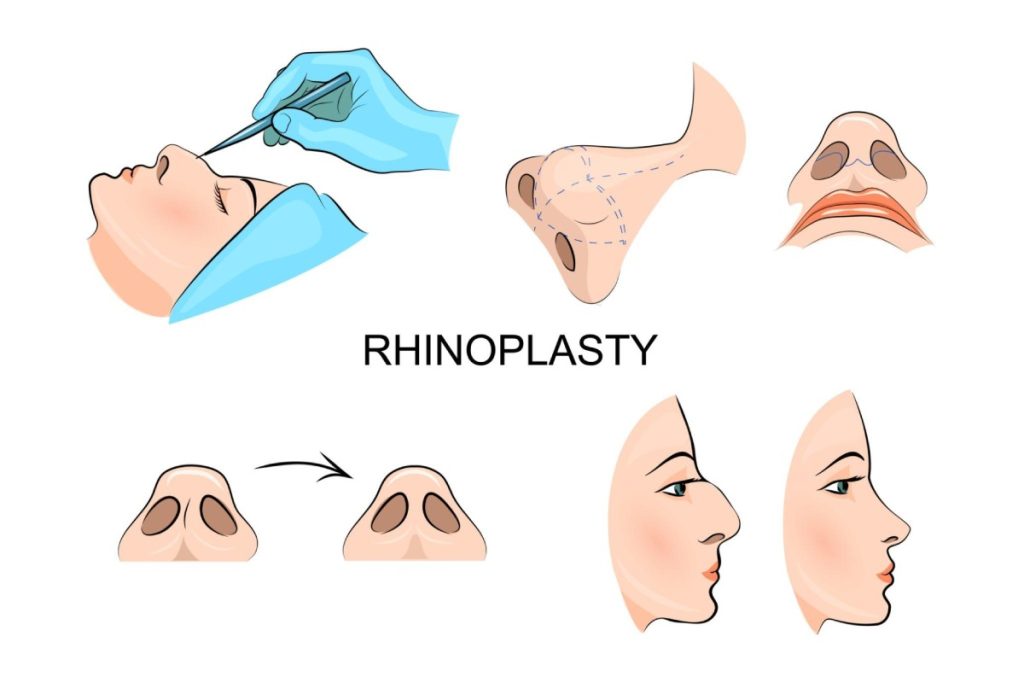All About Cosmetic Nose Surgery – Are you unhappy with the shape or size of your nose? Do you feel self-conscious about its appearance?
Rhinoplasty surgery, commonly known as a “nose job,” may be the solution you’ve been searching for. This popular cosmetic procedure can enhance the aesthetic appearance of your nose, as well as improve your breathing function.
In this blog, we’ll explore the ins and outs of rhinoplasty surgery, including what to expect before, during, and after the procedure. So, if you’re considering this transformative procedure, keep reading to learn more!
Table of Contents
What Is Rhinoplasty?
Rhinoplasty, also known as nose surgery, is a surgical procedure that aims to alter the shape, size, or function of the nose. It can be performed for cosmetic reasons, to improve the nose’s appearance, or for functional reasons, to correct breathing difficulties or other medical issues.
The procedure typically involves making incisions inside or outside the nose and manipulating the bone and cartilage to achieve the desired result.
What Should I Expect Before Rhinoplasty Surgery?
Before rhinoplasty surgery, there are several things that you should expect, including:
- A consultation with a board-certified plastic surgeon to discuss your goals and expectations for the procedure
- A physical exam and medical history review to ensure you are a good candidate for surgery
- Preoperative instructions, such as avoiding certain medications or supplements that can increase the risk of bleeding
- Imaging studies, such as X-rays or CT scans, to help plan the surgery and assess the structure of your nose
- A discussion of the surgical technique that will be used and the potential risks and complications of the procedure
- A review of the anesthesia options and any preoperative testing that may be required
- A discussion of the recovery process and any postoperative instructions, such as activity restrictions and wound care
What Should I Expect During Rhinoplasty Surgery?
Here are some things you can expect during rhinoplasty surgery:
- Anesthesia: General anesthesia is typically used for rhinoplasty surgery to ensure patient comfort and safety.
- Incisions: Depending on the specific goals of the surgery, the surgeon will make either an incision inside the nose (closed approach) or across the columella (the skin between the nostrils) in addition inside the nose (open approach).
- Reshaping: The surgeon will reshape the bone, cartilage, and/or skin of the nose to achieve the desired look and/or improve nasal function.
- Closing incisions: Once the desired reshaping is achieved, the surgeon will close the incisions with sutures or surgical glue.
- Splint and dressing: A splint and/or dressing may be applied to the nose to provide support and protect it during the initial healing process.
- Duration: The surgery typically lasts between 1-3 hours, depending on the complexity of the case.
What Should I Expect After Rhinoplasty Surgery?
Here are some things you can expect after your rhinoplasty surgery:
- You may experience some pain, swelling, bruising, and nasal congestion in the days following the procedure. Your surgeon will prescribe pain medications and provide instructions on how to manage these symptoms.
- You will need to wear a splint or cast on your nose for up to a week to help protect and support it as it heals.
- You should avoid blowing your nose or engaging in any strenuous activities that could increase blood pressure and potentially disrupt the healing process.
- And also, you may need to sleep with your head elevated to help reduce swelling.
- Your surgeon will schedule follow-up appointments to monitor your healing progress and remove any sutures or splints.
It may take several months for the final results of the surgery to become fully apparent. During this time, it’s important to be patient and follow your surgeon’s post-operative instructions carefully to ensure optimal healing and results.
Frequently Asked Questions
Who Is a Good Candidate for Rhinoplasty Surgery?
Good candidates for rhinoplasty surgery are healthy individuals who are unhappy with the size, shape, or function of their noses. It’s important to have realistic expectations and be in good overall health before undergoing the procedure.
Is Rhinoplasty Painful?
You may experience some pain and discomfort during the first few days after surgery. But this can be managed with prescription pain medication. Swelling and bruising are also common during the first few weeks but should gradually subside over time.
Can Rhinoplasty Surgery Improve Breathing Problems?
Yes, rhinoplasty surgery can be performed to correct structural issues in the nose that can cause breathing difficulties, such as a deviated septum.
What Are the Risks Associated With Rhinoplasty Surgery?
As with any surgical procedure, there are risks associated with rhinoplasty, including infection, bleeding, scarring, and changes in sensation or function of the nose. Discussing these risks with your surgeon and carefully following their post-operative instructions to minimize the risk of complications is important.
Will My Insurance Cover the Cost of Rhinoplasty Surgery?
Cosmetic rhinoplasty is typically not covered by insurance. But if the surgery is being performed for medical reasons, such as to correct a deviated septum or breathing difficulties, insurance may cover some or all of the cost.
